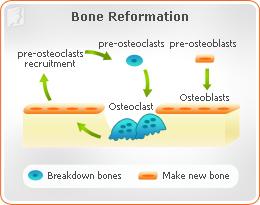Osteoporosis, a disease that often affects older women, is one of the most painful symptoms of menopause. The condition can vary in severity and is considered dangerous if not given appropriate medical attention. The following article outlines the link between menopause and osteoporosis in older women and provides some practical tips and advice on natural treatments for handling the condition.
What Is Osteoporosis?

Osteoporosis is a degenerative bone disorder in which the bones thin and become weaker. It is characterized by a general decrease in overall bone mass and density.
Human bones are composed of two major elements; the first, minerals like calcium (hence why milk is good for the bones) and phosphorous, the second- bone cells called osteoblasts and osteoclasts. Osteoclasts break down old bones while osteoblasts rebuild them. Both of these need to be working simultaneously to ensure healthy bones.
Quick Fact:
Osteoporosis affects millions of men and women worldwide, with more than 10 million currently struggling with osteoporosis in the United States alone. 50% of women and 12% of men will be affected by osteoporosis in their lifetime.Osteoporosis leaves the bones more vulnerable to fractures and breaks. The wrists, spine, and hips are often the body parts most likely to break in menopausal and older women as a result of falls or slight bumps and accidents. Such injuries can significantly hinder an older person's quality of life and independence.
What Is the Link between Menopause and Osteoporosis in Older Women?
During the menopausal transition, women experience decreased levels of estrogen. This loss of estrogen accelerates bone loss for a period of five to eight years because osteoclasts are given more opportunity to absorb and break down bone. The problem is often compounded by the fact that osteoblasts (cells which produce bone), aren't simultaneously able to produce more bone. This causes older women to lose more bone mass and density than normal.

Although accelerated bone loss during menopause has little relationship to calcium intake, some studies show that women over the age of 60 can improve their bone density by increasing their consumption of calcium.
Hormonal imbalance as a result of menopause is the primary cause of osteoporosis in older women. However, other causes of bone loss include; vitamin D deficiency, a lack of muscle strengthening and resistance exercises, and the use of certain medications.
Read on for more information about avoiding and dealing with osteoporosis.
Natural Treatments for Osteoporosis in Older Women
Osteoporosis is easier to prevent than it is to treat. Thus, the most important step in preventing osteoporosis is to control your estrogen and calcium levels. This can be achieved by maintaining a healthy diet with plenty of calcium and vitamin D and exercising regularly. There is also a range of pharmaceutical and alternative medicines that help prevent osteoporosis. These remedies often target the issue of hormone depletion itself, and therefore, are an effective way of preventing osteoporosis in older women.
Sources
- American Physical Therapy Association.(n.d)."What You Need to Know about Osteoporosis".Retrieved from www.apta.org.
- Cleveland Clinic.(n.d)."Menopause and Osteoporosis".Retrieved from http://my.clevelandclinic.org
- National Osteoporosis Foundation.(n.d)."Prevention: Who's at Risk". Retrieved from www.nof.org.
- New York State Department of Health.(n.d)."Calcium and Healthy Bones". Retrieved from www.health.state.ny.us.



